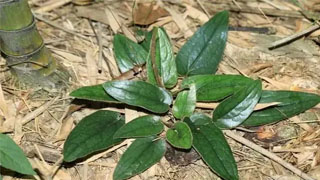
Nicknames: Rabbit Ear Grass (Cihang Living Book), Rabbit Ear Arrow, Golden Teapot (Wang Lianshi's "Herbal Collection Book"), Little Deer Carrying, Silver Teapot, Honeysuckle Grass, Moon Red ("Hundred Grass Mirror"), Rabbit Ear One Arrow ("Compendium Collection"), Pudi Golden Bell ("Quanzhou Materia Medica"), Tian Qing Di Bai, Lung shaped Grass, Mao Ma Xiang, Niu Yan Zhu Cao, Rubber Grass ("Hunan Medicinal Chronicles"), Da Zhong Ba Di Xiang ("Guizhou Medicinal Survey"), One Branch Fragrance, Pouring Qian Jin, Mao Lu Han Cao, Hong Jin Jiao Cup, Copper Spoon, Tie Jiao Cup, Tong Tian Grass, mountain butterfly, pig heart grass, rabbit ear gold border grass (commonly used herbs in Zhejiang folk), Ba Di Hu, cowhide vegetable, and Tian Tian Yi Zhu Xiang (herbs in Guizhou).
Medicinal parts: whole plant
Origin: Various regions in East China and Central South China
Family: Asteraceae
Original plant: Apricot Fragrant Rabbit Ear Wind (Apricot Fragrant Rabbit Ear Wind)
Plant condition: Perennial herb, grows on shady slopes.
Having shorter rhizomes in a creeping manner. Stem upright, 30-60 cm tall, with brown long hair, unbranched.
5-6 leaves, attached to the lower part of the stem, almost whorled; Oval shaped, 3-10 centimeters long and 2-5 centimeters wide. The apex is rounded and blunt, the base is heart-shaped, and the entire margin is wavy or undulating, with slightly sparse short serrations. The upper surface is green and hairless, and the lower surface is brown with long hairs. Sometimes the lower surface is purple red; The petiole is 3-10 centimeters long and has brown hairs.
The inflorescence is slender and elongated, with short or nearly sessile stems, forming a cluster of racemes. The bracts are slender, about 15 millimeters long and 3 millimeters wide; The bracts are multi-layered, with the outer layer being shorter and oval shaped, about 4 millimeters long, and the inner layer being lanceolate, 15 millimeters long. The tips are sharp, the flowers are white, and have a slight almond aroma.
The achene is needle shaped and elongated, measuring 4.5 millimeters in length and approximately 1 millimeter in width, flat, with a narrow base and longitudinal stripes and fine hairs; The crown hair is brownish yellow and about 10 millimeters long. The flowering period is from September to October.
Characteristics of Phnom Penh Rabbit Ear Medicinal Materials:
Golden edged rabbit ear medicinal properties:
[Taste] Sweet, cold.
① The Compendium of Materia Medica: "The taste is sweet and light. Cold in nature and bitter in taste. ""
② Quanzhou Materia Medica: "Bitter, cold, non-toxic. ""
③ Guizhou Herbal Medicine ":" Warm in nature, slightly sweet in taste. ""
[Guijing] "Gangmu Shiyi": "Enter the lung meridian.
【 Indications and Functions 】 Clearing heat, removing dampness, cooling blood, detoxifying, treating tuberculosis, coughing up blood, heat absorption, jaundice, edema, carbuncle, swelling and toxin, and scrofula.
① Wang Lianshi's "Collection of Materia Medica": "It enters the bloodstream, stops vomiting blood, and treats lung abscess. ""
② The Compendium of Materia Medica states: "To treat tuberculosis and vomiting blood. Perform blood cooling and clear lung fire. Treat symptoms such as vomiting blood, tuberculosis, lung abscess, lung dysfunction, jaundice, heartache, falls, wind, injury, coughing, hemoptysis, and swelling. ""
③ Quanzhou Materia Medica: "Clearing heat, purging lung fire, cooling blood, and stopping bleeding. Treat lung abscess, intestinal abscess, lung deficiency, bone steaming, tuberculosis, heat, abscess, swelling and toxin. ""
④ Hunan Medicinal Chronicles: "Anti inflammation and detoxification, hemostasis and muscle regeneration. ""
⑤ Guizhou Herbal Medicine ":" It disperses cold and relieves surface heat, promotes diuresis and dehumidification, detoxifies and softens the body, and calms the nerves. """
[Usage and Dosage] Oral administration: decoct soup, 3-5 yuan. External use: Rub or crush the nose.
[Attachment]
① Treating cough and vomiting blood: Apricot scented rabbit ear wind. Boil pig lung food. Er Xing Xiang Tu Er Feng costs three to five yuan. Boil it in water. (Hunan Pharmaceutical Journal)
② Treatment of edema: Two liang of a large variety of hibiscus root. Boil water and drink. (Guizhou Herbal Medicine) Erxian Apricot Fragrant Rabbit Ear Wind Root. Mash with salt and apply it to the navel. (Commonly Used Herbs in Zhejiang Folk Medicine)
③ Treating bone steaming fatigue and timidity: a rabbit ear with an arrow, steamed chicken clothing. (Compendium Collection)
④ Treating intestinal and lung abscesses: Two liang of rabbit ear grass, twelve tender leaves of white heather, and decoct with good wine. (Cihang Living Book)
⑤ Treating falls: Apricot scented Rabbit Ear Wind. Boil it in water.
⑥ Treating swelling and toxicity: Apricot scented rabbit ear wind. Crush and apply to the affected area.
⑦ Treating nasal chancre and insect disease: Apricot scented rabbit ear wind. Crush it and stuff it into your nostrils.
⑧ Treating knife wounds and snake bites: Apricot scented rabbit ear wind. Crush and apply externally. (Below is the "Hunan Pharmaceutical Chronicles")
⑨ Treating Jiuziyang: Dazhong Ba Di Xiang. Mash and apply to the affected area. (Guizhou Herbal Medicine)“


